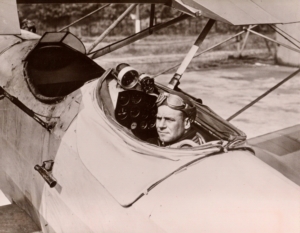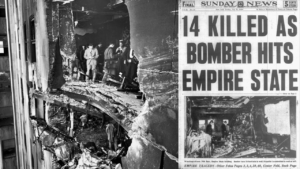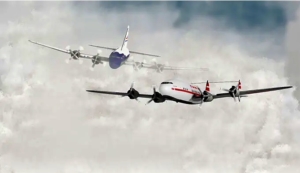The Big Sky is Falling
 Jimmy Doolittle with his blind flying" hood unzipped
Jimmy Doolittle with his blind flying" hood unzippedThe history of instrument flight (originally called blind flying) has had three distinct phases. The first began with Elmer Sperry's Gyro Horizon in the 1920s that allowed skilled pilots to fly through clouds by showing them where was the horizon they couldn't otherwise see. Race pilot Jimmy Doolittle used Sperry's gyro and a precision altimeter, a gyro compass and a primitive navigation radio in 1929 to make the first flight entirely under the hood" with takeoff, flight, and landing all without visual references. That Jimmy Doolittle was one hell of a pilot. But for the purposes of this column what I want to concentrate on is that in this first era of instrument flight the only thing Doolittle had to worry about hitting was the ground. Nobody worried about running into other airplanes because there were so few in the air that the possibility of collision was almost zero. They called it the Big Sky Theory.It's a big sky out there so don't worry about hitting anything.
And the Big Sky Theory generally held, with minor exceptions like the B-25 bomber that flew into the Empire State Building in 1945, which was attributed to an incorrectly set altimeter.
The Big Sky suddenly got a lot smaller on June 30, 1956 when the impossible happened and two airliners collided over the Grand Canyon killing everyone on both planes - 128 people in all. It was the first civilian crash to kill more than 100 people. The United Airlines DC-7 headed from LAX to Chicago was under Instrument Flight Rules and the TWA Super-Constellation headed from LAX to Kansas City was under Visual Flight Rules. Both had departed LAX within three minutes of each other, both were maneuvering around thunderstorms, and both were flying quite legally at 19,000 feet when they hit.
The result of this rare but now thoroughly possible crash was the institution of Positive Control for all instrument flights in U.S. airspace to this day.An FAA Air Traffic Controller tells the pilots what to do and ideally monitors compliance on RADAR.
The Big Sky Theory for flying may have died that day in the air above the Grand Canyon, but versions of it remain in effect in many parts of our society. If you are in an area where people are dying of COVID-19 and don't choose to wear a face mask, for example, you are applying a version of Big Sky.This version says that infected people are widely distributed enough that it is unlikely you'll get (or give) COVID no matter what you do, which is absolutely true right up to the point where there are enough cases to make it absolutely wrong.
In a big country, most people can behave anyway they like and get away with it though somebody - maybe not them - could still pay a price. So while I am making the behavioral decision, I am making it for both of us.
A version of this effect can be seen in murder statistics. Murder rates rise, for example, during natural disasters. With a hurricane coming or a wildfire burning, who is going to know that you hit your nasty neighbor over the head? Societal norms aren't what we think they are.
There is another version of Big Sky that applies to organized crime. I think of it as the Tony Soprano Theory. Tony Soprano, a successful New Jersey mafioso, could behave anyway he liked as long as almost everyone else followed the rules. Organized crime is parasitic. It relies on criminals being a minority because if there get to be too many crooks they will kill the host on which they have been feeding, in Tony's case the good citizens of New Jersey.
Taking this Soprano analogy a step further, organized crime relies for its success on many government functions working properly. Cash money (currency) has to have real value or it won't be worth stealing. Drugs have to be illegal to keep prices high and to scare competitors unwilling to take the risk of jail time. That makes law enforcement vital for a successful criminal enterprise. Tony wanted his mail delivered, his telephone to work, his garbage to be picked-up, and his pizza hot.
Another version of Big Sky applies to diplomacy between nations. We give foreign diplomats immunity from criminal prosecution as a quid pro quo to keep our ambassadors out of jail, too. It's a small price to pay, they say, but it is a price, relying on enough slop in the legal system that hardly anyone complains when immunity is invoked. Clearly there are victims of this policy or it wouldn't be a policy. Similarly, diplomatic negotiations between nations are all about giving-up things we might have preferred to keep in exchange for important concessions from the other side. If, say, U.S. farmers are inconvenienced by those concessions, we just give them subsidies paid for with money we will eventually forget that we borrowed. It's all leveraging systemic inefficiencies because they are difficult to measure. We can do it because we don't usually know how much it hurts.
Over the Grand Canyon that day in 1956 the pain of instrument flight was measured in 128 deaths and so that system changed. Any version of Big Sky won't change until the measurable pain of taking the risk exceeds the perceived pain of compliance.
Back to COVID, few people except the Lt. Governor of Texas would argue against masks if the situation was so dire that that fatality rates were 10 or 100 times higher than they presently are. Of course you can lay out the math and see that U.S. COVID cases are now 10 times higher than they were on March 30th, which makes it very possible that they could eventually be 100 times higher than March 30th before we have a usable vaccine. But we prefer not to do the math.
Big Sky theories break-down based either on shocking individual examples like the Grand Canyon air crash or on a slow realization that the trend isn't only bad, it is disastrous. That's the Big Sky aspect of Climate Change. People may argue that climate change isn't real or is a statistical aberration or is some natural cycle that we can't affect, because they'd rather not change their behavior. In this case people" can also mean companies, governments, and even political movements. If they are successful within the current system, why change it? And so the system won't generally change until the negative outcome is either obviously inevitable or until those who are profiting from change (solar energy, for example) become louder voices than those who are resisting change (Big Oil).
The environmental, labor, and tax changes promulgated by the Trump Administration, for example, benefit a particular minority of the population. It's a Big Country, a Big Economy, a Big Environmentand can probably tolerate some additional abuse is the excuse. Besides, when shit actually hits the fan it will be someone else's problem. He actually said that.
Another version of Big Sky is Inshallah, an Arabic language expression meaning if God wills" or God willing." The term is mentioned in the Quran and Muslims often use it when speaking about future events. Climate change or organized crime or the well running dry or uncontrolled instrument flight won't negatively affect us if we are on the correct side of God, Inshallah.
So Big Skycan be predestined: Make America Great Again, please.
The real enemy of Big Sky is data. We can have opinions, we can have beliefs, but a mountain of good data can tear Big Skyapart for those who will read the data and make the effort to understand it. That's what is happening in the emerging third era of instrument flight. Now we have navigational data so precise that it can take us from likely (but random) survival to almost certain death.
There are airways between cities and our WAAS GPS units with their one-meter precision can now send a faster airplane right up the ass of a slower airplane if they are flying to the same destination at the same altitude on the same airway and nobody is looking out the window. Of course we still have air traffic controllers and have recently added ADSB, which reports your exact position to all aircraft with which you might collide. Technology may save us, after all.
Or we can just continue to believe in the Big Sky. Jimmy Doolittle, who made that first all-instrument flight in 1929 and led a famous 1942 bombing raid on Tokyo, didn't die in a crash. He lived on the golf course at Pebble Beach in Carmel, California, dying in his bed in 1993 at age 96. Some people are just lucky.
The post The Big Sky is Falling first appeared on I, Cringely.

Digital Branding
Web DesignMarketing